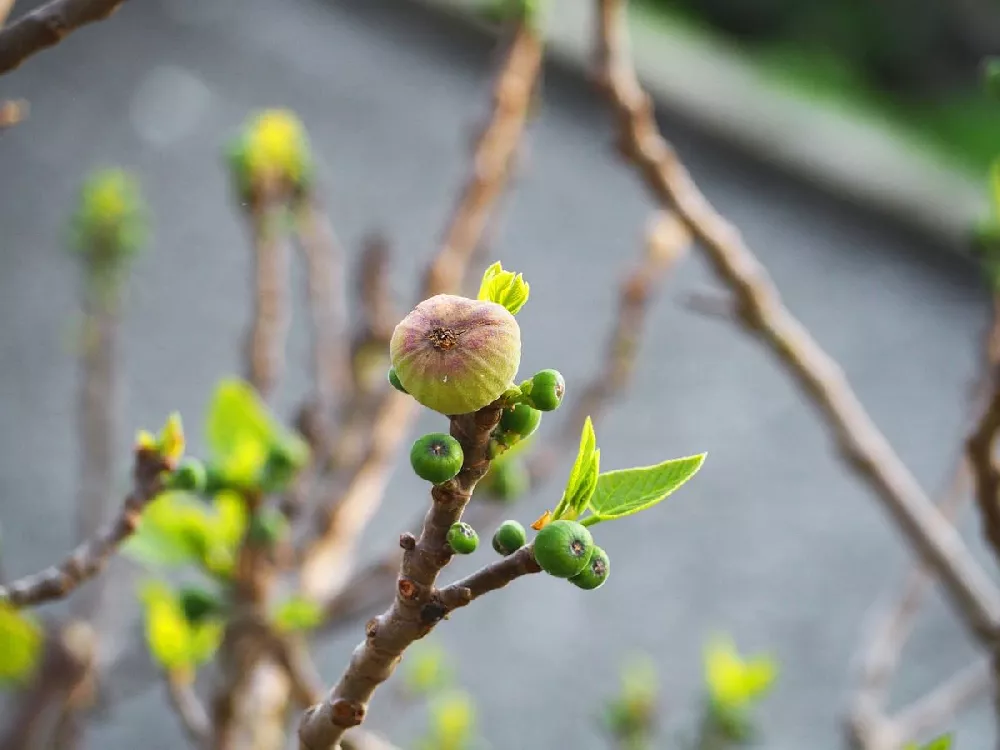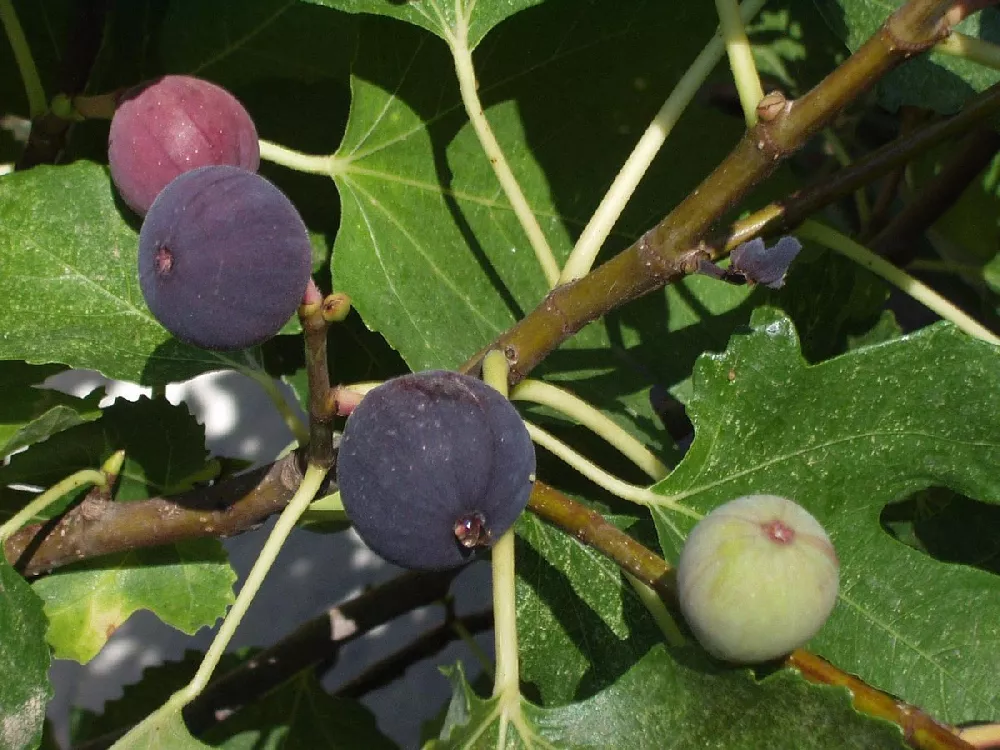- Home >
- Shrubs and Bushes >
- Brown Turkey Fig
Brown Turkey Fig for Sale - Buying & Growing Guide
- Ships in 1-2 days
- 1-Year Warranty Eligible
- Pots or accessories are not included unless specified in the product options.
Shipping Details:
Products shipped through FastGrowingTrees.com. Once your order is shipped, you’ll receive an email with a tracking number and estimated delivery date. Most orders will ship immediately.
The Brown Turkey fig, Ficus carica 'Brown Turkey,' is an attractive large shrub or small tree that is a welcome addition to the garden for several reasons. First, of course, is the fruit. Brown Turkey figs are sweet and juicy and can be eaten fresh or used in cooking. If you site your tree well and take good care of it, your tree may even reward you with two crops per year: a light crop in late spring and a larger harvest in early fall. Aside from the tasty fruit, the tree itself is an asset to the landscape, with deeply lobed leaves and an arresting silhouette. It's also not hard to grow and doesn't take a great deal of effort to grow successfully. Not convinced yet? Here are a few more reasons to invite a Brown Turkey fig tree to your garden:
- It can be grown either as a single-trunked tree or a multi-stemmed, large shrub.
- The Brown Turkey fig is resistant to pests and diseases.
- It can be grown either in full sun or partial shade.
Plant Care
Sunlight

The Brown Turkey fig tree can handle partial to full sun — four or more hours of direct sun a day.
Watering
Water your fig about once a week, giving it an inch of water each time.
Fertilizing

Give your fig a light feeding of a balanced, slow-release fertilizer, such as a 10-10-10 formula, in spring.
Planting and Care
Planting instructions
Site your Brown Turkey fig where it will get at least four solid hours of sunlight a day, in soil that is neutral or alkaline and drains well. Unpot your plant and tease out any encircling roots, which can slowly girdle the tree and kill it. Dig a hole that’s as deep as the root ball and twice as wide. Place the tree in the hole, spreading out the roots carefully. Fill in around the roots with topsoil that’s been mixed with well-rotted compost or manure, tamping down as you go to eliminate air pockets. Water thoroughly. Apply a 2- to 3-inch layer of an organic mulch, such as bark chips, around the root zone to hinder weed growth and conserve moisture, but don’t let it touch the trunk, which can encourage rot.
Watering and nutrients
A newly-planted fig tree should be watered every few days until you start seeing robust new growth on the branches. After that, you can taper back to a once-a-week watering unless you’re experiencing very hot or dry weather, in which case you should increase your watering. A mature Brown Turkey fig tree needs about an inch of water a week. If you’re not sure if it needs watering, check if the soil 2 inches below the surface is dry. If so, give it a good soaking. Brown Turkey fig trees are not heavy feeders, but if you want to encourage growth, you can feed yours with a balanced fertilizer, such as a 10-10-10 formula, in early spring.
Pollination
Fig trees are unique in their pollination method. They do not have traditional flowers but instead form a hollow receptacle, an inflorescence, that is not visible. Small wasps crawl into this receptacle and fertilize the reproductive organs, leading to the growth of the fruits themselves.
Pruning
Prune out any damaged, diseased, or dead branches whenever you see them. In early spring, do a more comprehensive pruning, removing between a quarter and a third of the older branches to encourage new growth.
Pests and diseases
Insect pests that may appear on your Brown Turkey fig tree include aphids, mealybugs, and spider mites. A healthy tree should have no problems handling minor infestations. If insect pressure persists, consider releasing beneficial predatory insects, such as lacewings and ladybugs, which eat aphids. Blight, rust, and leaf spot are diseases that may appear on fig trees. Avoid spraying water on the leaves and clean up leaf debris around the tree to help keep them healthy.
Harvesting
Figs are ripe when they turn a dark purple-brown color and taste sweet. Pull or cut them gently from the tree. Handle them as little as possible, since they bruise easily, and don’t let them pile up in your harvest bucket. Wear gloves and long sleeves when harvesting, as figs produce a milky sap that some people are allergic to. Your figs can be stored in the refrigerator but should be used or frozen as soon as possible.
Achieving maximum results
If you live too far north to grow the Brown Turkey fig outdoors, you’ll be pleased to know that this cultivar adapts easily to life in a container. Choose a pot for your fig tree that is roughly twice the size of the root ball with good drainage holes, and plant it in organic potting soil. The Brown Turkey fig is hardy down to 10 degrees Fahrenheit, so bring it inside in late fall and place it in a sunny window for the winter. Container-grown plants need more water and fertilizer than those grown in the ground, so monitor your tree carefully. If the soil feels dry a few inches below the surface, water it thoroughly.
FAQs
Where can I grow a Brown Turkey fig tree?
How big does a Brown Turkey fig tree get?
If planted outdoors, your fig can grow to a height of 10 to 25 feet, with a width of 10 to 15 feet. Height is determined partly by the quality of the soil your tree is growing in as well as its general care. A container-grown fig won't reach those heights, since its roots are constrained by the pot. Expect your pot-grown fig to max out at a height of about 6 to 8 feet.
Is a Brown Turkey fig a tree or a shrub?
Actually, it can be grown as either. If you wish your fig to take on a more shrub-like shape, allow several main trunks to grow from the ground without trimming them out. You can achieve a more tree-like shape by pruning out all but the strongest central trunk when the tree is young and diligently trimming out any suckers that appear at the base of the trunk.
Compare Similar Products
You can't add more Product Name - Product size to the cart.
OK









